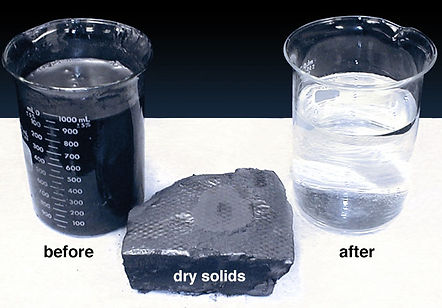

The Oberlin Filter is a completely automated pressure filter the delivers clean liquids and dry solids.
99.99% of total suspended solids removed from liquid
The Oberlin Filter has the ability to remove solid particles down to 1 micron in size.

The before is water contaminated with fly ash from a flue gas scrubber application. The after is the clean water. The solids removed are in a dry cake in the center.
The filtered solids are extremely dry
No further dewatering is necessary
Examples of Dryness by Solids Type
-
75%-95% Crystalline and Rigid Shaped Particles
-
45%-65% Diatomaceous Earth/Filter Aid Backwashes
-
30%-40% Metal Hydroxides
Completely Automatic
The filter cleans liquids and discharges solids in a completely automated process. An operator is not needed to remove solids or clean the inside of the filter. The dry filtered solids discharge automatically into a bin. This provides for greater safety when hazardous materials are involved.
Using pressure and a cake of filtered solids for ultra fine filtration
The Oberlin Filter pumps dirty liquid through a very tight media in a self contained chamber. Solids build into a cake on the media which catch more solids. Pressure continues to force the liquid through the densely packed cake and media. The filtered liquid is incredibly clean with all solids removed down to 1 micron in size. For a reference in scale, 70 microns is the average diameter of average human hair.

A thick cake of solids that has built up inside of the filter being discharged. The dirty liquid is pumped through cakes like this on the filter media resulting in ultra fine filtration down to 1 micron.
High Flow Rates
The Oberlin Filter delivers high flow rates for it's compact size. Our smaller sized filters with a filtering area of 2 Sq. Ft. have flow rates of up to 80 gallons per minute depending on the application. Our larger filters with 50 Sq. Ft of filtering area have flow rates of up to 2,000 gallons per minute.

Large Scale Projects
The Oberlin Filter is used in large-scale projects in a variety of filtration applications covering wastewater, coolant and hot oil. The world's largest manufacturers rely on us for our reliability and ability to filter large volumes of liquids and delivering the filtered solids in a dry cake. We are used on a national level in projects that involve the security and health of the country, including chemical weapons destruction programs and groundwater cleanup
Four OPF 24 Filters in an application of filtering silicon wastewater from the grinding of solar photocells. The OPF 24 has the ability to individually process up to 960gpm depending on the application.
Reusable Filter Belts
Oberlin has been building paperless filters for over 25 years. Our cleanable belt systems have been saving customers thousands of dollars annually in media costs. In the case of a change in application or process, all Oberlin pressure filters are engineered for easy conversion for media utilization.
Disposable Filter Paper
In applications where disposable media is required, the Oberlin Filter uses up to 20 times less paper then other types of filters. The use of pressure in the filtration process allows the filter to use the same section of paper for long periods of time. Filter cycle times can range anywhere from 30 minutes to 12 hours.
Reusable Belt Filter: Coolant filtration for a grinding steel bearings application. Cakes of filtered metal fines being discharged.
Disposable Filter Paper: Hot frying oil filtration in a coated chicken application. The filtered crumbs are being dischared from the filter in a dry cake.
The Filtration Process
The process of the Oberlin Filter is to pass liquid contaminated with solids through media, trapping the unwanted solids in and then on the media. As the unwanted solids build up on the media, the flow of the liquid is impeded. Unless the liquid is highly pressurized, the flow of the liquid through the filter will drop quickly and not satisfy the flow capacity required. The filter pressurizes the liquid by pumping it into a chamber whose only outlet is through the unwanted solids on the media. The pressure is limited only by the size of the pump, not by atmospheric pressure. 30-40 psi is typical of an Oberlin Filter. This is about three to four times more pressure than a gravity or vacuum filters can develop.
Below are the basic steps of operation for the filter.
Sequence of Operation
-
The filter uses a pneumatic airbag to keep an upper and lower platten together with a liquid tight seal while solid bearing liquid is pumped through the filter media.
-
Once the pressure inside the filter has reached 30-40 psi,pressurized air is fed into the upper platten, forcing the remaining liquid through the filter media leaving a dry cake.
-
The upper platten lifts, the dry cake is rolled out on the filter paper and into a hopper.
-
The fully automated system then begins another filtration cycle.






